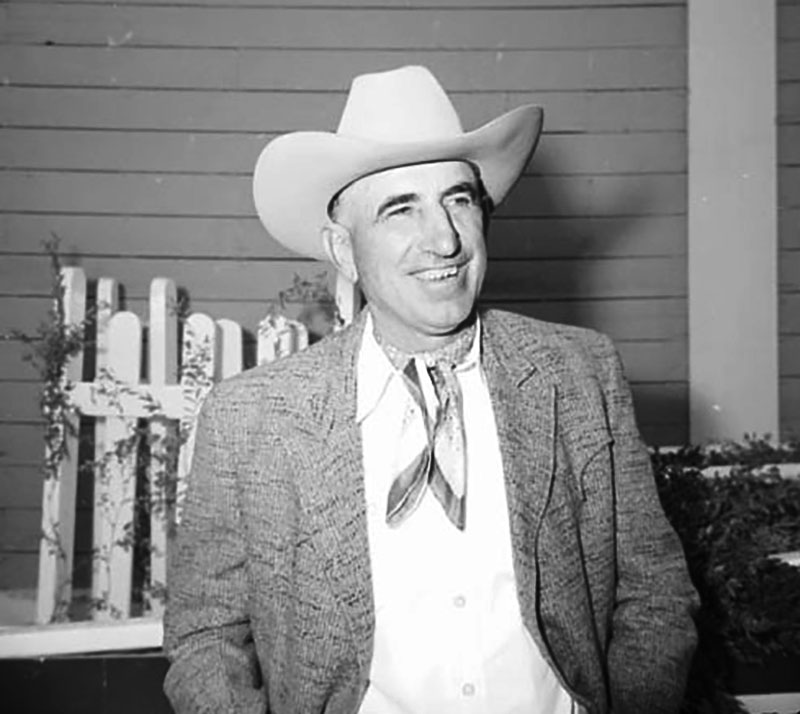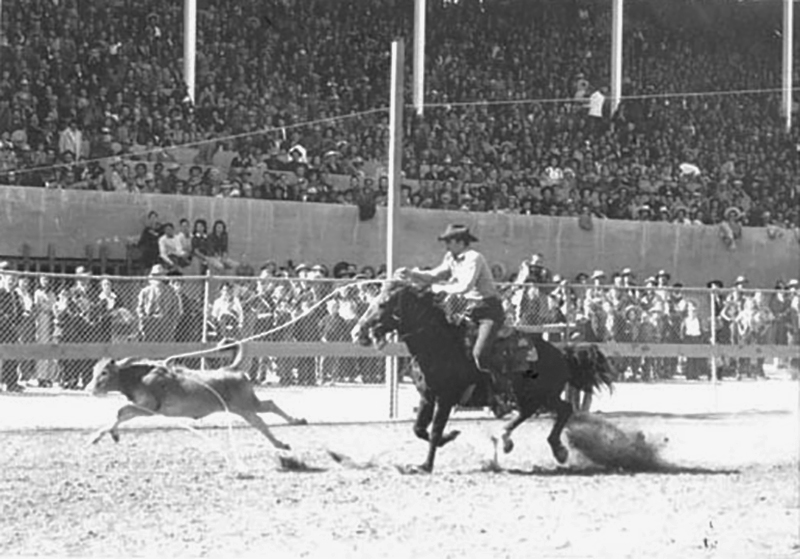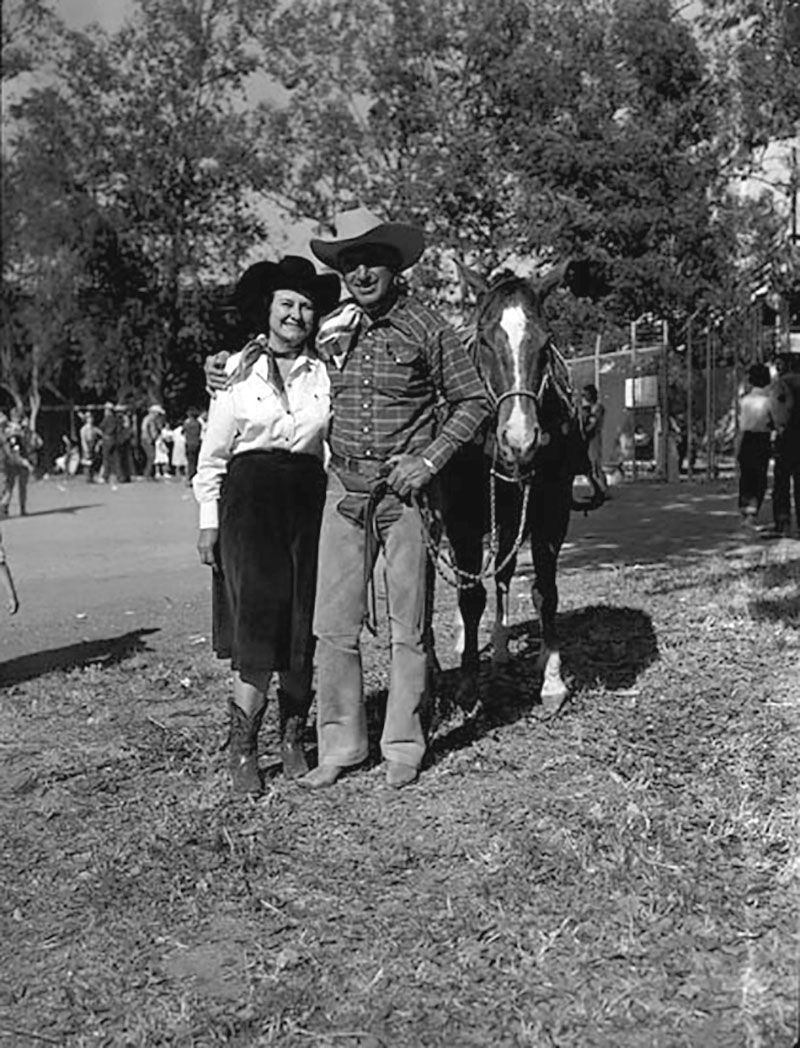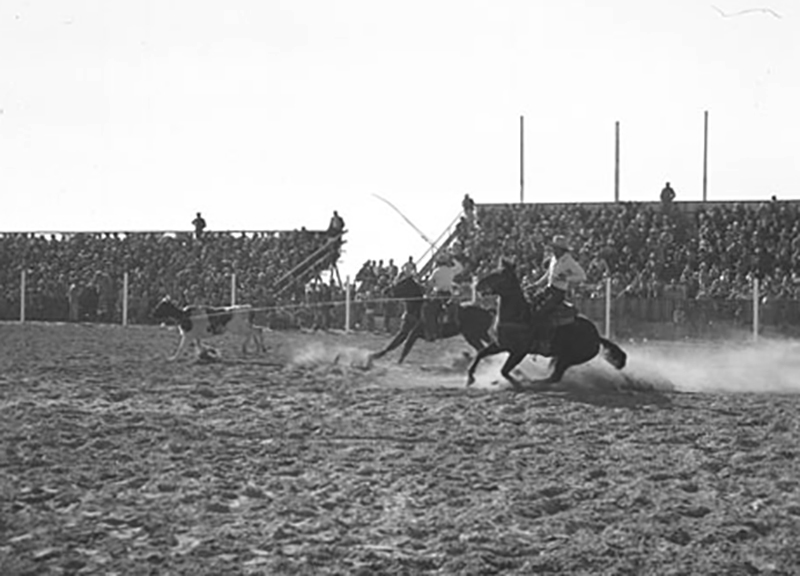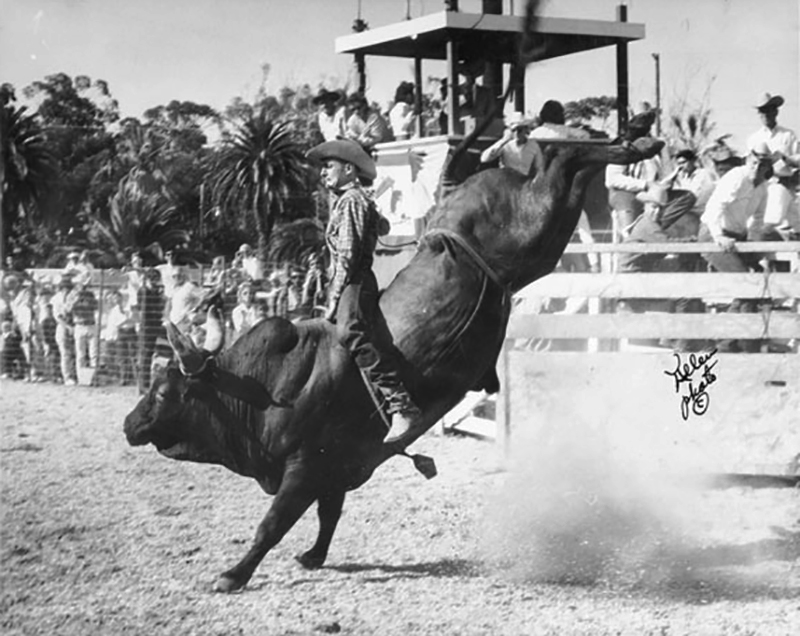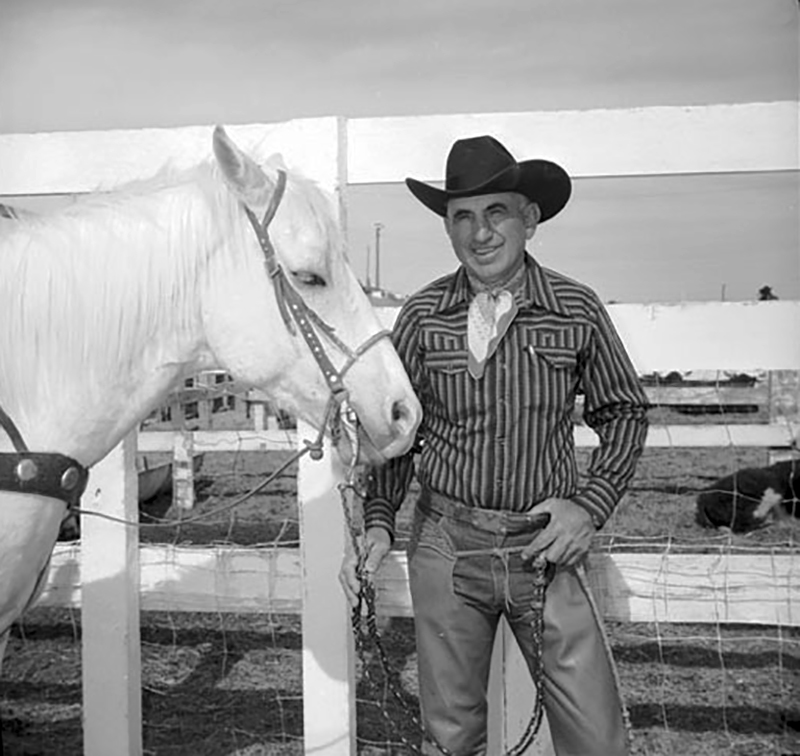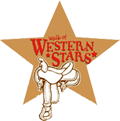|
|

Andy [Jauregui].
Originally published in Rodeo Sports News, Denver, Colo. | July 25, 1978.
Manuscript courtesy of Drew Rust, 2017.
|
The cheering of a rodeo crowd was no stranger to my father's ears. He was given a standing ovation one year in Cheyenne, Wyo., in the steer roping. I remember the steer coming out of the chute with Dad close behind, the steer making a sharp left turn and heading straight for the grandstands. Mother, my sister Julain and I were sitting about halfway up in the stands with a perfect view of the action. There was a low railing all the way around the inside of the racetrack that circled the arena. Before the steer reached the rail, Dad roped and tripped him, sailed over the rail on his horse onto the track, stepped off his horse, jumped back over the rail, ran to the steer and finished tying him just as the horse pulled them to a stop against the rail. It happened frighteningly fast, Dad handling it as if there were no obstacle or danger. The crowd went wild. Mother, Julie and I stood there with tears streaming down our cheeks, grateful he hadn't been hurt, and going crazy with excitement at how terrific he was. It was by natural inheritance that Andrew came into the world of men who made their livelihood in the raising of cattle. He was born Liandro Jauregui to Frank and Isabella Jauregui in 1903. His ancestors migrated to the United States via South America, from the Basque Country of the Pyrenees Mountains between France and Spain. Dad's father and uncle carried on the tradition of the sheepman and ran over 6,000 head of sheep on a ranch near Santa Paula, Calif. In the late 1800s, they lost nearly all of them in a severe drought and started over again raising cattle, sheep and goats. My father's responsibilities and livestock education were acquired at an early age. "When we moved to the home ranch in Wheeler Canyon," he said, "I was about four years old. I got my first horse to ride when I was five — rode him about three miles to a little ol' country school. I wanted to ride all the time." The sixth of 13 children, Dad was raised on the big ranch in Santa Paula. I've always felt his warmth and humor came from growing up with five brothers and seven sisters.
His interests were centered on riding, roping and working with stock. It was the quick response and innate ability to handle assignments, even in these growing-up years, that gave the hint of destiny. This ability was so obvious to his father that he was allowed to leave school in the sixth grade, at 13, to help his older brother, Pete, run the ranch. Dad drove a team of mules, herded cattle, sheared sheep and helped farm. Gaining experience riding bucking horses on a neighboring ranch and practicing roping calves in a back field in every spare moment provided him with the skill that would one day make him a rodeo champion. "I rode in front of an audience for the first time when I was 15," Dad recalled. "A cowboy named Jesse Stahl — Jesse became one of the first great black cowboys of rodeo — came to Oxnard in the early '20s to break horses off the ranches. One day Jesse got a bunch of colts and advertised a rodeo. Had it in a ball park. He gave us guys — Joe Yanez and me, a neighbor of mine that rode awful good — $2 apiece to get on these colts. "There weren't any chutes. We just snubbed them and climbed on." Dad grinned. "You might call that my start in show business. The next year I entered a rodeo in Santa Barbara. They didn't have judges. The prize money was $15 for the man that got the biggest hand from the grandstand. I rode a horse called Madam Hurry. Had on a pair of angora chaps. They broke loose and flew off. I rode the horse without any trouble and got the $15. That was my first winnings at a rodeo. "When I was 17 I left home for a while to contest in some of the bigger rodeos. At a show in Hemet, I learned that Pellisier's Diamond Bar Ranch in Chino needed a horseman to work stock. I went for an interview and got the job, only it didn't last long. When they took me off my horse and put me to chopping weeds, I left for home in a hurry. Didn't have luggage, so it was easy. Weren't many rodeos then; mostly fairs where they'd pay mount money — $10 a mount on bareback horses and ten on saddle broncs." I asked him when he first saw Mother. "At the fair in Ventura," he said. "I saw this real good lookin' gal waiting with some friends to get on the Ferris wheel. This fella with me said she was new in town. I bet him I'd be the first to date her."
Dad was a little slow; he didn't get that date until three years later when they met at a local dance. When he learned that the tall, handsome fellow with her was only her brother, he made up fast for the past three years by asking to take her home. "The first time I saw your father, I was coming out of the local drug store," Mother said. "He had just gotten off his horse and was bent over fixing the pant leg in his boot. He looked up with that darling grin and winked. Well, that was it. I wasn't interested in anyone else from then on. "I saw him after that riding at fairs and thought he was great. A friend told me he was Andrew, one of the Jauregui boys. Everything I heard about him added to my first impression, and I made up my mind he was the one for me. So, when he asked to take me home from the dance, I accepted. Nine months later, on June 15, 1924, we were married in St. Sebastian's Church in Santa Paula. Your daddy was 21 and I was 20." (Interestingly, Dad's birthday is Feb. 10, and Mother's is Feb. 11.) At this time, Dad was partners with a fellow who had made a deal to rent riding horses for the summer to dudes in the San Bernandino mountains. Mother said she and Dad felt the mountains would be a romantic place to spend their honeymoon. I laughed when she told that the boys, after the wedding reception, tried to throw Dad in the big watering trough at the ranch, only she and the seven sisters stopped them. Then off they went for three months spent living in a tent and wrangling dudes. "After we left the mountains," Dad said, "I went to work for C.Y. Jones running his stable in Newhall. Your mother and I moved into the little house where you and Julain were born." C.Y. Jones was known affectionately as "Fat," and the Fat Jones Stable furnished stock and equipment (wagons, buckboards, etc.) for movies. Several years later, Carol, one of Fat's daughters, married Ben Johnson, champion roper and motion picture Academy Award winner. Both are dear friends of our family. Dad's work with Fat led to his early career as a motion picture stuntman, doubling for actors in Western movies. Some of the stars he doubled for were Richard Dix (with Irene Dunne) in "Cimarron," Warner Baxter (with Delores del Rio) in "Ramona," and Leroy Mason (also with Delores del Rio) in "The Revenge."
Although not political by nature, my father was quick to take responsibility toward his fellow man. He was appreciative of his own good fortune, hard earned though it was, and gave with no thought of repayment. In a business where publicity was sought after — and high on the list of job perpetuation — he never allowed his personal charity and generosity to be other than anonymous. The man he gave to, when he saw the need, never had to feel the debt. Andrew had the ability to recognize potential in others and did whatever necessary to see it realized. One of the first people he became a mentor to was a young, freckled-faced boy named William "Red" Lamoreaux. Dad got Red a job doubling for the child star, Frankie Darro. "Andrew was a second father to me. I was just a scruffy kid," Red said, laughing. "All I had was a pair of tennis shoes and a dollar-fifty Carlsbad hat. I told your folks I was an orphan. They took me in, and Andy bought me a pair of chaps — he had the letters R.E.D. put down each side — a shiny pair of boots and a cowboy hat. I really thought I was somethin' when I got rid of them tennis shoes." After meeting Red's folks, my parents realized what an imagination he had. Dad saw terrific potential in Red and talked the studio F.B.O. (which would become R.K.O.) into signing him to a contract. Red proved to be a dynamite actor. The studio changed his name to "Buzz Barton," and he became one of their biggest stars and money makers of that era. In 1928, our family moved to the ranch in Placerita Canyon. Dad was on location, so some of the boys who worked at Fat's stable helped Mother load their belongings on a wagon, and up the canyon we went. My parents named it the "J-Spear Ranch." Baldy O'Neil, a ferrier (blacksmith and horse-shoer) who was one of the most colorful characters to work on the ranch, named it the Rancho Griefo. The name remained. There was always a crisis — humorous, tragic, hilarious, improbable and exasperating. An assortment of livestock, barefoot kids, on-location picture companies and cowboys camping along the creek made the ranch a Western "Walton's" with cowboy humor. Some of the cowboys who camped at the ranch to make the California rodeos were Everett Bowman, Hugh and Ralph Bennett, Asberry Schell, Gene Ross, John Bowman, Gene Pardee, Floyd Stillings and Dick Robbins — most of them with their families. I can still hear Everett Bowman's wild cowboy yell echo through the valley every morning when the sun came up. When we moved to the ranch, Dad and Fat had become partners in a herd of cattle. In 1933 Fat moved his stable from Newhall to North Hollywood. Dad bought out Fat and dissolved their partnership. He kept on with stunt work; he began building his herd of cattle and acquired good bucking stock (two of the J-Spear's greatest bucking horses, Whiz Dang and Cheyenne, were honored at the Golden State Finals in 1972); and he rodeoed on weekends. With consistent winnings, rodeo life started taking more of his time and interest. He went on locations less and traveled to rodeos more. At about this time his younger brother, Edward, came to work for him, and again he assumed the role of mentor.
"I'd graduated from high school and was getting under foot at home," Ed said, "so my dad sent me to Andrew's, figuring he'd be a good influence on me. Andy taught me to work horses and rope. Your dad was one of the best stuntmen around then. He didn't ask for jobs; they called him. He was busy furnishing stock to rodeos for much stunt work, so when a call came for a location job, he told the studio he was sending me, and that I could handle it. His word was good enough for them. They hired me and I was started on my life's work. Edward is a top teamster as well as outstanding stuntman. His ability to drive any kind of team got him a part in "Ben Hur" starring Charlton Heston, on location in Rome. He drove one of the chariots in the most breathtaking and spectacular race ever filmed. He doubled such stars as Gable, Wayne and McCrea, just to name a few, and was Lorne Green's double for the 10- year run of Bonanza. I have a special memory of my uncle Ed: He gave me my first saddle when I was six. "I'm aware there are men who ride as well as my father — only to me he looks better on a horse then anyone — and every time he roped, my heart stood still. I couldn't breathe until it was over. Roping to Dad was like a keyboard to Liberace or a football to Namath. He loved it. In the summer, we always had dinner late at the ranch; Mom knew Dad he and the boys would be at the arena, roping until sundown. Dad won the World's Championship in Steer Roping in 1931 and Team Roping in 1934. "One of the biggest thrills of my life was when I won the 1938 Cheyenne, Wyoming, Calf Roping Championship," Andrew said. After he won the Championship Saddle (now in the Cowboy Hall of Fame) in Phoenix, Ariz., in 1941, he started easing away from the nomadic life of the rodeo cowboy to becoming a full-time stock contractor and arena director. His integrity is legendary. His word was as good as an iron-bound contract. Rodeo committees as well as cowboys respected and valued his friendship. Lex Connelly, one of rodeo's finest announcers — an outstanding contestant himself and a close friend of my parents — said Andy was a main contributor among the few men who brought rodeo from an informal cowboy sport to the fast-paced, smooth-running spectator attraction of today. Lex said that through the years, the famous "Jauregui growl," which was far worse than his bite, grew to be a legend throughout the rodeo world. When Andy growled, even the most reluctant cowboy moved because he knew the arena director was right. When asked for a tribute to my father, Lex said, "Andy is the most respected and revered man ever known in rodeo." One show Dad handled for 18 years was the Los Angeles Coliseum. It was the biggest one-day rodeo ever. He went in with a large crew of men, five trucks and trailers loaded with over 200 head of livestock, set up the portable chutes and arena, and in a matter of hours put on a spectacular show. That evening, everything was struck, cattle loaded and on their way back to the ranch. By dawn, the Coliseum was as empty as it had been at dawn the day before. I love the story Dad tells about a man named Fletcher sending him three horses and saying he could keep or sell them. Dad sold two and kept a sorrel 2-year-old to break and school. He paid Fletcher half of the money and agreed to pay the rest when he sold the horse. About five years later, Dad won the calf roping at a rodeo in the Wrigley Field ballpark. After the show, a man walked out from the stands to congratulate him. Andy recognized Fletcher, the man he had lost contact with, and said: "Say, I still owe you money for this horse." Fletcher laughed and told him to forget it. But Dad happily made out a check for him, glad finally to own his beloved calf horse, Rowdy. Dad won nearly every championship and hundreds of ropings on him, and to top it all, his brother, Edward, placed second and another cowboy placed third — that same day — all three of them mounted on Rowdy. Andy's "Let's get with it, boys," became famous. Harry Carey, a dear friend, neighboring rancher and one of America's greatest character actors, got such a kick out of the phrase that he used it in one of his Western movies. William S. Hart had the utmost affection and respect for my father. He gave him one of his cars, a classic Chrysler convertible touring car with a rumble seat. We used it for everything, including hauling hay for the stock, until it finally fell apart. Today it would be a collector's dream. "The first time I heard of Andy Jauregui was from Will Rogers," said Joel McCrea. "We were on location in Lake Tahoe. I was playing my first juvenile lead. Will kept talking about Andy Jauregui. When we got back to the Fox Studio in Hollywood, Will asked me out to his ranch to rope some calves. Andy had brought him. He kept talking about a horse he was buying from Andrew, who had the reputation with Will of being the best horse breaker he knew. Will and your father were great friends."
My father, rodeo cowboys and a movie stuntman I know agree that among motion picture actors, no one rides a horse as well as Joel McCrea. He told me the secret of his success was that he rode good horses, and that the best horse he ever rode was broken and trained by my father. The horse was called Ribbon. He was a 5-year-old, bald-faced sorrel stallion. Joel rode him in his movie "Buffalo Bill." It was Ribbon's first picture, and Joel said, "He was incredible. Had the best stop of any horse I've ever ridden. We had him doing everything. He was a great horse, and I agree with Will: No one could break and school a horse better then Andy." Joel made many movies on Dad's ranch and used Ribbon in almost all of them. Dad and Joel have had a warm and lasting friendship since 1930 and a bond in their mutual love for Will Rogers. Andrew, ready to retire, sold his J-Spear Rodeo Co. in 1967 to Ed Rutherford. However, several rodeo committees would not hear of having their show without Andy, so he remained for a few more years, making the changeover less abrupt. His retirement was honored by the awarding of the Robert Paxton McCulloch Trophy at the Casey Tibbs Cowboy Reunion at Pueblo West, Colo. The magnificent bronze sculpture was presented for 50 years of outstanding contributions as a rodeo contestant, stock contractor and arena director. Andrew and Camille have been married 54 years and had four daughters: Julain, Noureen, Joann and Andreena. Their romance is like a movie script. Andy has all of the qualifications of a leading man, and Camille is his incredibly beautiful leading lady. The sport of rodeo and I share a debt of gratitude to this unique man, Andy Jauregui. He has given both of us a hero. What he has contributed to rodeo will live on as long as the sport. The other day a new horse was brought to the ranch for the grandchildren to ride. Dad insisted on trying him out first. We were concerned, as he hadn't been on a horse for some time and suffers from arthritis. We wanted to help, but he got on fine. As he rode off across the field, his shoulders straightened, the years fell away, and he was young again — the best-looking cowboy I've ever seen on a horse.
* All photos from National Cowboy & Western Heritage Museum Dickinson Research Center Archive.
1. Photo by Devere Helfrich; Devere Helfrich Rodeo Photographic Collection; No. 81.023.15257. 2. Photo by Devere Helfrich of Klamath Falls, Ore.; Gene Lamb Collection; No. 1990.016.103. 3. Photo by Devere Helfrich; Devere Helfrich Rodeo Photographic Collection, No. 81.023.18624. 4. Photo by Devere Helfrich; Devere Helfrich Rodeo Photographic Collection, No. 81.023.05727. 5. Photo by Ben Allen of Pasadena; PRCA Rodeo Sports News Photographic Collection, No. 98.008.5937. 6. Photo by Devere Helfrich; Devere Helfrich Rodeo Photographic Collection, No. 81.023.24223-09. [Original manuscript] |
Story by Andy Jauregui 1935
Andy Jauregui & Wm. S. Hart 1938
Andy Jauregui Bio by Noureen Baer 1978
Profile: Andy & Camille 1984
Jauregui's 1934 Saugus Rodeo Ribbon
Branded Pitcher
Tim McCoy in The Man from Guntown 1935
The Ivory-Handled Gun 1935 (Mult.)
FULL MOVIE: The Gunman from Bodie 1941
Gene Autry in The Singing Hill 1941
Forbidden Trail 1941
Eddie Dean in Tumbleweed Trail 1946
Randolph Scott in Trail Street 1947
Gene Autry in Strawberry Roan 1948 x3
Alias Jesse James 1959 (Mult.)
Canadian Club Ad 1969
|
The site owner makes no assertions as to ownership of any original copyrights to digitized images. However, these images are intended for Personal or Research use only. Any other kind of use, including but not limited to commercial or scholarly publication in any medium or format, public exhibition, or use online or in a web site, may be subject to additional restrictions including but not limited to the copyrights held by parties other than the site owner. USERS ARE SOLELY RESPONSIBLE for determining the existence of such rights and for obtaining any permissions and/or paying associated fees necessary for the proposed use.
